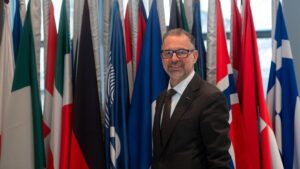New ESA director general outlines priorities
By Jeff Foust

WASHINGTON — The new head of the European Space Agency has outlined his priorities for the next several years, ranging from improving relations with the European Union to increasing commercialization activities.
The ESA Agenda 2025 document, released by the agency April 7, is an expression of how its new director general, Josef Aschbacher, wants to use the agency to ensure Europe retains a role as a global leader in space.
“Europe, in my opinion, needs to have a serious debate on where Europe wants to be in the next 10 to 15 years” in space, he said during a call with reporters to discuss the 17-page report. That includes the role of space in the economy and strategic plans, and for “bringing new energy, new enthusiasm, new inspiration through new space programs.”
That plan has five priorities for the agency’s next four years, the duration of Aschbacher’s first term as head of the agency. They include strengthening ties with the EU, increasing commercialization activities, developing space safety and security programs, working through “critical program challenges” with existing programs and transforming ESA’s internal processes.
At the top of the list is improving relations with the European Union, which have become strained in recent years as the EU expands its space ambitions. The EU cooperates with ESA on the Galileo satellite navigation program and Copernicus series of Earth observation satellites, but the EU has shown an interest in new efforts, like a broadband satellite constellation, and creating a European Union Space Program Agency to oversee its activities.
Aschbacher, who earlier this year expressed a desire to ensure ESA was the “go-to agency” for the EU’s space activities, said an immediate priority is finalizing a long-delayed Financial Framework Partnership Agreement (FFPA) between the two organizations governing their cooperation on space activities.
“We’ve restarted with fresh energy the negotiations,” he said, including a joint letter signed by Aschbacher and Thierry Breton, commissioner for the internal market at the European Union, signaling their intent to hammer out an agreement on the FFPA.
He declined to discuss the specific issues that kept the two sides from reaching a deal. “So far we are making positive progress,” he said. “Both sides have a very strong intention to move ahead swiftly. We hope to be ready with agreement and get it approved by both sides by the middle of this year.”
Part of that effort to improve ESA-EU relations described in the agenda is a proposal for a “Space Summit” conference in the spring of 2022, which would bring together European nations for a high-level meeting, perhaps at the head-of-state level, to discuss Europe’s plans for space. The document states that the meeting could be the forum to announce a new European flagship space program to join Galileo and Copernicus, such as the EU’s proposed broadband constellation or alternatives, like a new space traffic management initiative. That event would be separate from ESA’s next ministerial meeting, scheduled for late 2022.
Another priority, supporting commercial space activities in Europe, is a response to the growth of American space startups. “The investment by private people in space in the U.S. is much bigger than it is in Europe, and there is, I think, a need to do something,” he said.
The agenda outlined three ways to support European commercial space activities, such as encouraging talent to stay in Europe, improving contracting mechanisms and partnerships to provide demand for European space startups, and speeding up how ESA works with companies. “We need to be more responsive, more dynamic in order to be of relevance to these companies,” he said, “and to make sure we are adding value and not in the way of these companies.”
Two other elements of the plan, involving space safety and security and critical program challenges, involve existing ESA programs. In space safety and security, Aschbacher called for an analysis of the capabilities and needs of ESA member states to “identify complementary activities” that ESA can pursue for the next ministerial meeting.
One critical program challenge involves access to space. “International competition is putting a lot of pressure on our launcher developments,” he said. A near-term priority is successfully introducing the Vega-C and Ariane 6 vehicles in 2022, but he said ESA needed to think about future vehicles as well, incorporating technologies such as reusability. That includes, he said, “encouraging competition to a larger extent than we have seen in the past.”
Amid those various programs, Aschbacher said a fifth priority is reshaping ESA itself, noting a fifth of its employees are eligible to retire by 2025. While those retirements mean a loss of expertise, he described it as an opportunity to bring in people with knowledge in other domains, as well as improve the diversity and gender balance of the agency’s workforce.
All those changes, he said, are meant to keep Europe competitive with other major space powers, including the United States and China. He noted China was “very active” but didn’t discuss specific opportunities for cooperation, although ESA officials recently talked with counterparts at the China National Space Administration.
A day before releasing ESA Agenda 2025, Aschbacher spoke with Steve Jurczyk, NASA’s acting administrator, to reaffirm their cooperation on a wide range of science and human spaceflight efforts. “From my perspective, I would like to have a strengthened relationship with NASA,” he said. “There’s lots of opportunities on the horizon.” He added that improving relations between the United States and the EU under the Biden administration may also offer new space cooperation opportunities.
April 8, 2021 at 04:46PM
via SpaceNews read more...

Post a Comment